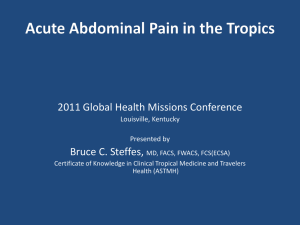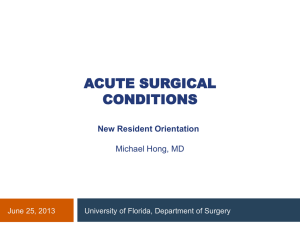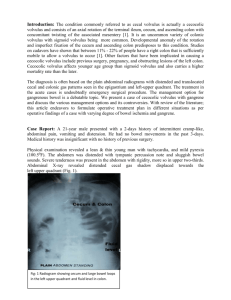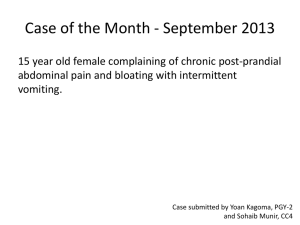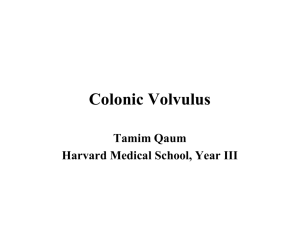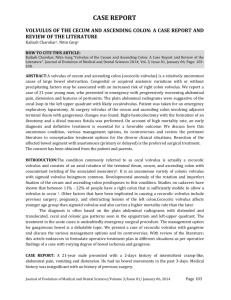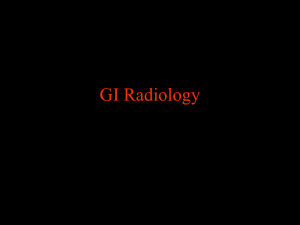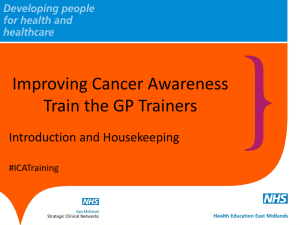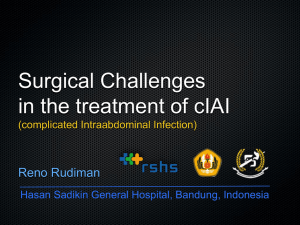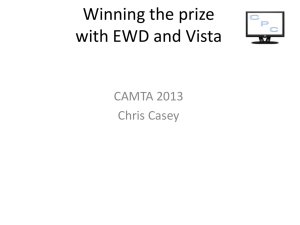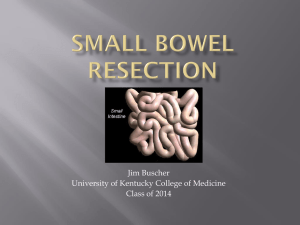Abdominal pain tropics GMHC 2014 - PPT
advertisement
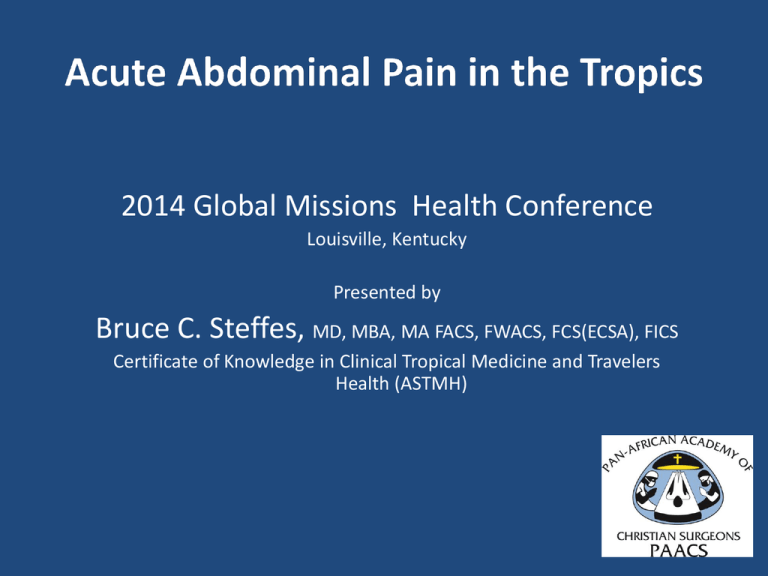
2014 Global Missions Health Conference Louisville, Kentucky Presented by Bruce C. Steffes, MD, MBA, MA FACS, FWACS, FCS(ECSA), FICS Certificate of Knowledge in Clinical Tropical Medicine and Travelers Health (ASTMH) Introduction • Surgery in the developing world is different – Different diseases - or at least different prevalence – Advanced pathology – Fewer care givers – Limited resources Diseases seen less commonly in the developing world • • • • Diverticulitis Acute and chronic cholecystitis Appendicitis Small bowel obstruction due to adhesions Abdominal diseases seen more commonly in the developing world • • • • • • Primary peritonitis Perforated duodenal ulcers Volvulus Adult intussusception Tuberculous peritonitis Pigbel (Clostridial necrotizing enteritis) What are diagnoses seen in the two-thirds world? • University Hospital in Ghana – Appendicitis – Perforated typhoid • Bongolo Mission Hospital, Gabon – Incarcerated/strangulated hernias – Appendicitis – Volvulus – Adhesive SBO – Perforated typhoid What are diagnoses seen in the two-thirds world? • Tenwek Mission Hospital – Volvulus – Appendicitis – Perforated PUD – Trauma – Perforated typhoid – SBO Hoof Beats ARE Zebras Differential Diagnosis of SBO • Hernias • Ascariasis • Adhesive small bowel obstruction • Peritoneal tuberculosis • Volvulus • Intussusception Differential Diagnosis of SBO • Hernias – Small hernias are more likely to incaracerate than large ones. – Don’t forget the uncommon hernias (especially femoral) Differential Diagnosis of SBO • Hernias • Ascariasis • Adhesive small bowel obstruction – Lower incidence than in N. America but increasing as surgery becomes available – PID may be the cause Differential Diagnosis of SBO • Hernias • Ascariasis • Adhesive small bowel obstruction • Peritoneal tuberculosis • 15-20% have concomitant pulmonary TB • Acute form – Ascites – Thickened omentum – Scattered tubercles • Chronic Form – Matted viscera – Cysts and obstruction Differential Diagnosis of SBO • Hernias • Ascariasis • Adhesive small bowel obstruction • Peritoneal tuberculosis • Volvulus • Small bowel volvulus – Usually associated with malrotation – May be in areas of high worm burden • High index of suspicion and early intervention Differential Diagnosis of SBO • Hernias • Ascariasis • Adhesive small bowel obstruction • Peritoneal tuberculosis • Volvulus • Intussusception • < 3 y.o. hydrostatic reduction • >3 – adults. Surgery • Adults are more common than children in series from Nigeria, Uganda and S. Africa. • Colocolic intussusception is uncommon but more common in areas with high rate of amebiasis. • Reduction should be tried only if the patient is stable Air or water can be used with ultrasound for reduction Differential Diagnosis of LBO • Volvulus – Approximately 50% – Sigmoid and Cecal – “Volvulus belt” • Diminished frequency of colon cancer and diverticulitis Case Study • 42 y.o. M with a history of occasional smoking and occasional alcohol intake • Acute abdominal pain, more severe in the upper quadrant. • He doesn’t present for 16 hours after onset. • PE: tachycardia, tachypnea and a nearly rigid abdomen. Perforated Peptic Ulcer • 10%+ - no previous symptomes • 10% melena – usually minor • 90% have pneumoperitoneum Surgery for Perf’ed DU • • • • Graham omental patch (open or laparoscopic) Rarely definitive surgery Occasionally non-operative treatment Surgery >12 hours after perforation has much increased morbidity/mortality Medical Rx after Surgery • Only 50% develop recurrent ulcer symptoms • With the routine post-operative treatment of Helicobacter pylori and careful symptomatic treatment, most will never require surgery. • Medical Treatment – Metronidazole and Clarithromycin resistance is increasing. Both protocols are about 80% effective if no resistance; 30% is resistance – Cost and availability of drugs determine preferred regimen Case Study • 5 yo boy from Papua New Guinea. • Pig feast 5 days before • Severe abdominal pain 4 days during with fever, nausea & diarrhea. Intermittent cramps, especially with eating & drinking • WBC 14,400 • Abdomen initially soft. • Dx? Initial Tx? • NPO, nasogastric tube and antibiotics • “Dark” NG output, “dark” diarrhea and abdomen became “surgical” Dx? Pigbel • (Enteritis Necroticans, Necrotizing Enteritis) was reported first in medieval Europe and again in Germany after WWII when it was called “darmbrand” (gut-fire). It resurfaced in the early 1960s in Goroka, PNG. • Vaccination has reduced this one-common diasease. Incidence of Pigbel • Male > Female (2.2:1) • 70% between ages 1 – 10. • Can be seen in young adults (25%) • More common in dry season (more pig feasts) Bacteriology of Pigbel • Clostridium Perfringens Type C (also known as Clostridium welchii) = Anaerobic, gram +, spore-forming rod - found in human stool, pig stool and soil • Spores are heat stable up to 95 C (Boiling point of water is 95 in the PNG Highlands) • Type A commonly causes food poisoning (botulism). Type C grows in protein-rich chyme and produces a b – toxin). Types of Pigbel: • Mild Diarrheal (type IV) • Subacute Surgical (type III) • Presents later • Complication of Type II (See next category) • Mortality: 49% Types of Pigbell • Acute Toxic (type I - Fulminant toxemia and shock in immunological naïve) – mortality 85% • Acute Surgical (type II - Present with ileus, small bowel obstruction (SBO), strangulation, perforation, peritonitis) - Mortality: 42% • Subacute Surgical (type III - Presents later as Complication of Type II disease) - Mortality: 49% • Mild Diarrheal (type IV) The Clinical Course • Symptoms usually become apparent 48 hours after a large meat or protein meal but can present up to a week later • Present with colicky or constant abdominal pain, vomiting with dark emesis (blood flecks), blood in stool, foul flatus (meteorism), and diarrhea early • Tachycardic, febrile, dehydrated, tender & distended upper abdomen with visible bowel, guarding, rigidity, decreased bowel sounds The Clinical Course • Symptoms consistent with ischemia • Pain out of proportion • Eating may increase pain • Late symptoms: partial SBO, malnutrition, fibrosis, adhesions, malabsorption and strictures (especially with Type III) • Mortality due to peritonitis, septicemia, dehydration, electrolyte abnormalities, and shock Diagnostic Approach • • • • • High index of suspicion & early intervention critical Gas in bowel wall or SBO on abdominal x-ray Bloody NG aspirate or blood in stool Neutrophilic leukocytosis (>/= 20,000) Serological test possible, ? availability (immunoflorescence using type C coated silicon beads) • Culture C.P. from stool (anaerobic blood agar) • Bloody ascites on ultrasound Treatment of Pigbel • Correction of fluid and electrolyte deficits; hydrate well; correct moderate to severe anemias. • Nasogastric drainage • Intravenous antibiotics - Chloramphenical, Crystalline PCN and Metronidazole/Tinidazole (+/- Gentamicin) Treatment of Pigbel • Treatment of Ascaris • ?treatment of malaria • Consider hyperalimentation or TPN if course prolonged • Antiserum +/- (Not readily available or effective) Surgery • Due to the rapid progression of pigbel, the decision for surgery is often a judgment call by the surgeon based on clinical experience • Urgent laparotomy with wide resection of SB to normal margins • Questions that arise: • How much bowel to resect? • End-to-end anastomosis vs. 2 ostomies • Which patients to receive a second look? Surgery Findings • • • • • • Palpable loops of thick bowel Enlarged mesenteric nodes typical “Tiger Striping” “Skip Lesions” Mucosal Ulcerations Perforations/SBO Enlarged mesenteric nodes typical “Tiger Striping” “Skip Lesions” Mucosal Ulcerations Case Study • 10 yo Togolese boy presents in the dry season with history of fevers and malaise. He has had intermittent nausea and mild diarrhea. He was treated for malaria. He worsened 48 hours ago and hasn’t eaten since then. • Dx, Rx? Typhoid fever • Cause: – Salmonella enterica serovar typhi – Certain non-typhoid salmonella (NTS), particularly Paratyphoid strains A, B, C. • Disease of poor sanitation, often seasonal Typhoid Fever Bitar & Tarpley, Reviews of Infectious Diseases 7:257-271, 1985 Clinical Features of Typhoid • Classically a four week disease • Weeks one and two: fever, headache, abdominal pain • Week three: “typhoidal state” with disordered mentation and toxemia • Week four: Defervescence and improvement Lab in Typhoid Disease: • Leukopenia/thrombocytopenia are common • Culture is the best diagnostic tool – but may not be available. Widal? • Widal test: very controversial • Conclusion of a paper by Tupasi et al ([Phil J Microbiol Infect Dis 1991, 20(1):23-26] “Culture isolation of Salmonella typhi from blood and bone marrow should be considered the standard diagnostic test to confirm typhoid fever. A single Widal test in an endemic area is of no diagnostic value. In addition, it should not be used as a screening test in asymptomatic individuals. Neither should a "negative" Widal test rule out the diagnosis of typhoid fever in patients with signs and symptoms of the disease since a "negative" Widal test may be seen early in the course of illness. The Widal test should not also be used as the basis for deciding the duration of antimicrobial therapy.” Alternative to Widal • Cheaper and as accurate If Surgery Indicated Emergently • Aggressive resuscitation prior to OR with appropriate antibiotic coverage (triple antibiotics to cover GI flora as well as Salmonella) and sharing of the Gospel • Ampicillin and chloramphenicol are no longer the drugs of choice. Fluoroquinolones (?decreasing efficacy) and third generation cephalosporins are probably the best at present. Indications for Surgery in Enteric Fever • Surgery for carrier state is NOT a usual indication. Normally, do only for chronic cholecystitis per se (doesn’t always work for carrier state) • Hemorrhage (1.5 - 10% of patients, bleeding usually in 3 or 4th week, usually UGI in type and may be hard to find if in the small intestine) • Perforation (1 - 5% of patients, common in the second and third weeks of illness, but can be much later. Some patients perforate without an obvious prodrome) • Mortality for perforation is as high as 40%, affected by many factors in the austere environment. Indications for surgery: • Pneumoperitoneum on x-ray (may require left lateral film) • Persistent palpable mass (especially with erythema of abdominal wall) • Diffuse peritonitis or positive peritoneal tap • Persistent sepsis/failure to improve on medical therapy • Suspicious of abdominal catastrophe but negative x-rays? Do frequent examinations (by the same or equally experienced examiner) and x-rays (q. 6 h at first) until improvement or perforation is evident. Typhoid – Pneumoperitoneum Typhoid – Perforation Surgical Approach • Multiple perforations – Up to 3 or so – oversew – Multiple – consider resection with single anastomosis • Aggressive peritoneal debridement and/or irrigation of the peritoneal cavity Surgical Approach • Consider retention sutures • Consider a second-look operation • A negative laparotomy is rare and better tolerated than a missed perforation. Typhoid Cholecystitis • Acute cholecystitis – very uncommon • Predominance in children • Often advanced (gangrene or perforation) because of low index of suspicion Courtesy, Dr. J. Brown, Cameroon Typhoid Cholecystitis • Acute cholecystitis – very uncommon • Predominance in children? • Often advanced (gangrene or perforation) because of low index of suspicion Case Study • 8 year old female presents with abdominal swelling, pain and vomiting. WBC 14,200. 6% eosinophilia. Hg 8.9 gm%. A sausageshaped RLQ mass was palpated. Ascariasis & Volvulus - Xray Ascariasis • These common roundworms only cause problems in two situations – When they migrate – When they don’t Ascariasis – Migrating • Loeffler’s syndrome (non-surgical) • Biliary-pancreatic • Anastomotic perforation Non-migratory – Bowel Obstruction • Diagnosis – – prevalence varies widely by locale and age – May have history of recent Antihelminthic treatment – Physical examination – Plain x-ray – Contrast studies – especially with Gastrografin ® – Ultrasound and CT scan Ascariasis – Bowel Obstruction • Diagnosis – – local prevalence varies widely – Prevalence varies by age group – Physical examination – Plain x-ray – may see worms superimposed on SBO appearance – Contrast studies – especially with water soluble contrast Medical Treatment of Ascariasis • If no peritonitis, rehydration and nasogastric decompression • Some prefer no vermicidal treatment at all. • Those who treat debate between mebendazole or albendazole versus piperazine. • Hypertonic saline enemas? • Public health education for all. Treatment • Operative vs. nonoperative management – – – – – Does the patient have peritonitis? Is the patient toxic? How long has the child had symptoms? Does X-ray suggest complete SBO? Is the child worsening on nonoperative treatment? Surgical Treatment of Ascariasis • Milk the worm bolus through into colon if possible. • If not effective, transverse enterotomy and removal of worm bolus with primary closure. – Prevent spills into peritoneal cavity (bacterial infection) – Close anastomotic line securely (to prevent worm migration) – Ue antibiotic prophylaxis. • 1/3 will require resection Surgery for Ascariasis Ascariasis & Volvulus Case Study • 29 year old male with 24 hours of marked distension, supraumbilical cramping pain and obstipation. WBC 12,000. 3% esosinophilia. No peritoneal signs. • Diagnosis? Treatment? http://www.learningradiology.com/caseofweek/caseoftheweekpix2008-2/cow338arr.jpg Sigmoid Volvulus - Facts • Wide age range • More common in males (most series 2:1) • Most common form of GI volvulus Sigmoid Volvulus - History • • • • Rapid onset of pain and remarkable distention Obstipation Prior episodes Nausea/vomiting as obstruction persists Diagnosis • Massive distention • Empty rectum • Characteristic X-ray – Massive distention of colon “bent inner-tube” sign (aka “coffee bean sign,” “horse’s butt”. – +/- small bowel distention – Empty left iliac fossa – No rectal gas • CT or BaE if questionable Sigmoid Volvulus - Management • Resuscitation of fluid and electrolyte deficits • Antibiotics • If no peritonitis, urgent rigid or flexible sigmoidoscopy with rectal tube placement (sutured) • Urgent laparotomy for signs of peritonitis or failed sigmoidoscopy Sigmoid Volvulus – Surgical Options • Semi-elective laparotomy after successful endoscopic detorsion with placement of rectal tube • Sigmoidopexy has a high recurrence rate • Low morbidity and mortality rate for semielective resection and anastomosis Cecal Volvulus • • • • • Clinical characteristics Similar presentation with sigmoid volvulus More common in females Preoperative diagnosis much more challenging Gangrene of colon is common Cecal Diagnosis - Diagnosis • X-ray: Suggest obstruction. Only 1 in 5 are diagnostic • Barium enema: high rate of accuracy but challenging without fluoroscopy. Bird’s beak seen at point of volvulus. • Colonoscopy: difficult in unprepared colon and there is high risk of perforation Cecal Volvulus • Only 1 of 5 x-rays are “classic” • Dilated loop in cecal volvulus tends to end in the right upper quadrant Cecal Volvulus - Surgical Options • Decompression alone has 50% recurrence • Detorsion and cecopexy: May recur if cecopexy is not extensive • Detorsion and cecostomy: most authors feel this procedure should be abandoned as complication rates can be 50% • Right hemicolectomy Cecal Volvulus – Surgical Options • If gangrenous, resection required – Resection and ileostomy with mucus fistula: choice for septic/unstable patients with comorbid conditions – Resection (partial or complete right colectomy) with anastomosis +/- colopexy Compound Volvulus • Usually refers to sigmoid volvulus associated with small intestinal volvulus • Detorsion is often difficult and confusing. • Detorsion of necrotic gut may be dangerous. • In situ stapling and then restoration of continuity. Compound Volvulus Double Volvulus • Ileostomy should be avoided if at all possible • Short gut syndrome is one possible result but not usual. Second look laparotomy should always be considered for questionable bowel in setting of possible short gut syndrome • Lack of immediate improvement after endoscopic detorsion of presumed sigmoid volvulus should lead the surgeon to the OR so as not to miss small bowel volvulus Case Study • 9 year old female presents with 24 hours of anorexia, increasing abdominal pain and increasing fever. She has non-localizing rebound and guards in all quadrants. • Differential diagnosis? Primary Peritonitis • • • • • Occurs in previously health children Very rare problem in the West Disease of children, especially girls, ages 6-10 Females much more common than males Cause is not understood Presentation • • • • Rapid onset (usually <48 hours) Fever and leukocytosis with severe abdominal pain Tenderness often most severe in RLQ Very difficult to distinguish from acute appendicitis Treatment • Exploratory laparotomy with appendectomy and washout (nosurgeon wants to sit on a case strongly suggesting acute appendicitis) • Laparoscopy with washout (if equipment available) • Broad spectrum antibiotics until culture results available • Some authors have suggested a paracentesis with strep species or Pneumococcus on Gram stain would obviate the need for laparotomy. Bacteriology • Strep species are most common in most reports • E. coli • Mixed aerobe/anaerobe Summary: Primary peritonitis • A disease causing a rapid onset of an acute abdomen with vomiting and diffuse peritonitis, especially in girls, which usually resolves quickly after surgery for diagnosis and antibiotic therapy. Thank you! Bruce.steffes@paacs.net
